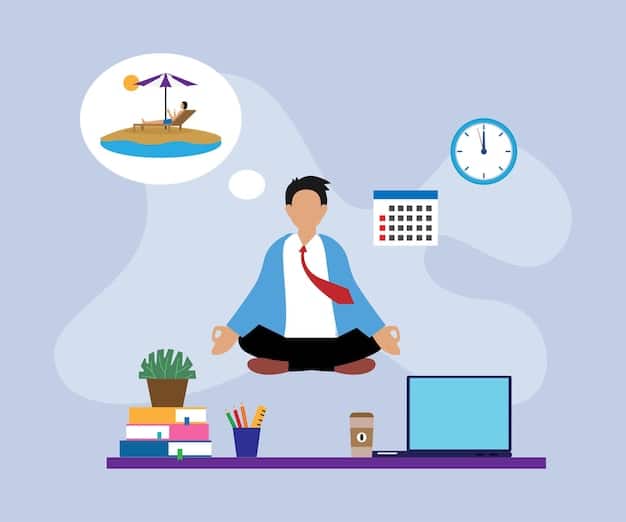Reclaim 15% of Your Workweek: Updated Eisenhower Matrix 2025 Guide

The updated Eisenhower Matrix for 2025 offers a powerful framework for strategic prioritization, enabling professionals to effectively categorize tasks, minimize distractions, and reclaim up to 15% of their workweek by focusing on high-impact activities and delegating or deleting low-value work.
Are you constantly feeling overwhelmed by your to-do list, struggling to make a dent in truly important tasks amidst a sea of urgent demands? You’re not alone. Many professionals find themselves caught in this cycle, but what if there was a proven method to significantly improve your productivity and free up valuable time? This article explores How to Reclaim 15% of Your Workweek with the Updated Eisenhower Matrix in 2025, offering a refined approach to an enduring time management classic that promises to transform how you approach your daily responsibilities.
Understanding the Eisenhower Matrix: A Timeless Foundation
The Eisenhower Matrix, a powerful time management tool, helps individuals prioritize tasks based on urgency and importance. Its roots trace back to Dwight D. Eisenhower, who famously said, “I have two kinds of problems, the urgent and the important. The urgent are not important, and the important are never urgent.” This simple, yet profound, philosophy forms the bedrock of the matrix, dividing tasks into four quadrants: Do, Decide, Delegate, and Delete. Understanding this fundamental concept is the first step toward regaining control over your workday and optimizing your output.
The core idea behind the matrix is to shift focus from merely reacting to urgent tasks to strategically addressing what truly matters for long-term goals. By explicitly categorizing every item on your to-do list, you gain clarity and minimize decision fatigue. It’s about being proactive rather than reactive, ensuring that your energy is directed toward activities that yield the greatest impact on your professional and personal life.
The Original Quadrants and Their Purpose
Each quadrant of the traditional Eisenhower Matrix serves a distinct purpose, guiding immediate action or strategic planning. Misinterpreting these can lead to continued overwhelm, so a clear understanding is crucial.
- Quadrant 1: Urgent and Important (Do): These are crises, pressing deadlines, and significant problems that require immediate attention. They are often unavoidable, but a well-managed workday aims to minimize tasks falling into this category through proactive planning.
- Quadrant 2: Important, Not Urgent (Decide/Schedule): This is the quadrant of strategic planning, relationship building, personal development, and preventative measures. Tasks here are vital for long-term success but lack immediate pressure, making them easy to defer if not proactively scheduled.
- Quadrant 3: Urgent, Not Important (Delegate): These tasks often create a sense of urgency but contribute little to your core goals or those of your team. They are frequently interruptions, some meetings, or requests that can be handled by others.
- Quadrant 4: Not Urgent, Not Important (Delete): This quadrant includes time-wasters, distractions, and insignificant activities that provide no real value. Identifying and eliminating these is crucial for maximizing productivity.
The power of these quadrants lies in their ability to force an honest assessment of your daily activities. It’s about moving beyond simply “doing” and instead “strategically acting” on what truly moves the needle. A disciplined application of these principles can significantly reduce stress and improve output.
Why the Eisenhower Matrix Needs an Update for 2025
While the original Eisenhower Matrix remains a powerful conceptual tool, the modern work environment—characterized by hyper-connectivity, remote work, and an explosion of digital tools—presents new challenges that necessitate an updated approach. The volume of incoming information and the blurred lines between work and personal life demand more nuanced strategies for effective prioritization. Simply categorizing tasks isn’t enough; we need to account for digital overload, collaboration complexities, and the constant pull of notifications.
The traditional model, in its simplicity, sometimes struggles to address the sheer cognitive load of managing multiple projects, asynchronous communication, and the pressure of always-on availability. In 2025, an effective time management system must not only help prioritize but also integrate seamlessly with contemporary workflows and psychological insights into productivity. It’s about evolving the framework to meet the demands of a more dynamic and demanding professional landscape.
Addressing Digital Overload and Constant Connectivity
The advent of digital communication tools has undoubtedly streamlined many processes, but it has also created a new beast: the constant notification stream. Emails, chat messages, project management alerts, and social media pings can quickly derail focus. This constant digital bombardment often creates a false sense of urgency, pulling important Q2 tasks into the urgent Q1 or Q3 categories.
A 2025-ready Eisenhower Matrix must incorporate strategies for managing this digital chaos. This means not just categorizing the tasks themselves, but also the channels through which tasks arrive and the optimal times to engage with them. It’s about building boundaries in a boundaryless digital world, ensuring that technology serves productivity, rather than hindering it with endless interruptions.
Integrating Modern Productivity Principles
Modern productivity science offers valuable insights that can enhance the traditional matrix. Concepts like deep work, flexible work schedules, and the importance of mental well-being were less prevalent in Eisenhower’s era but are critical in 2025. An updated matrix should encourage practices that foster sustained focus and prevent burnout.
This involves not just task categorization, but also mindful scheduling, incorporating breaks, and recognizing the ebb and flow of personal energy levels. The goal is to create a system that is not only efficient but also sustainable, allowing individuals to maintain high levels of productivity without sacrificing their mental health. The updated matrix needs to be a holistic tool, not just a task sorter.
The Updated Eisenhower Matrix 2025: Key Enhancements
The 2025 iteration of the Eisenhower Matrix introduces several key enhancements designed to make it more relevant and effective in today’s fast-paced work environment. These updates move beyond simple task categorization to incorporate strategic thinking around digital hygiene, collaboration, and personal energy management. The goal is a more robust system that helps professionals not only prioritize but also execute with greater focus and less stress.
Introducing “Digital Detox” and “Strategic Breaks” Quadrants
The incessant demands of digital life can easily blur the lines between urgent and important, or even between work and personal time. The updated matrix implicitly endorses “Digital Detox” and “Strategic Breaks” as critical components for sustained productivity, moving beyond mere task management to proactive well-being.
* Digital Detox Integration: This isn’t a fifth quadrant, but rather a cross-cutting principle. Before categorizing tasks, consider a “digital pre-filter.” For example, schedule specific times to check emails and messages (e.g., 2-3 times a day) rather than reacting to every ping. Any task that seems urgent but comes through an unscheduled channel should be immediately questioned for true importance. This proactive approach prevents the urgent-but-unimportant tasks from ever reaching your main prioritization framework. It also encourages setting strong boundaries to protect focus.
* Strategic Breaks as Q2 Imperatives: Previously, breaks might have been considered Q4 (not urgent, not important). In the updated model, “Strategic Breaks” are firmly Q2 tasks. They are important because they prevent burnout, improve cognitive function, and enhance creativity, even if they aren’t urgent in the moment. Scheduling dedicated time for mindfulness, short walks, or even just stepping away from the screen actively contributes to long-term productivity and well-being, transforming these from optional luxuries into essential components of an effective workday.
These additions acknowledge that modern productivity isn’t just about what you do, but also what you consciously choose NOT to do, and how you recharge to do your best work.
Emphasis on “Collaboration & Delegation” with AI Integration
Collaboration is inherent in many Q3 tasks (urgent, not important to you, but important to someone else), and technology offers new avenues for delegation. The 2025 update stresses optimizing these interactions.

Modern teams are rarely silos; tasks frequently involve input or handover to others. The updated matrix emphasizes a more deliberate approach to delegation, moving beyond simply passing off work. This involves:
- Clear Communication: When delegating a Q3 task, provide comprehensive instructions, define necessary context, and set clear expectations regarding deadlines and desired outcomes. This minimizes back-and-forth and ensures the task is completed correctly the first time.
- Empowerment through Training: Instead of repeatedly delegating the same simple task, consider if it’s an opportunity to cross-train a team member. This shifts a recurring Q3 for you into a potential skill development opportunity for someone else, reducing your future workload.
- Leveraging AI for Triage and Routing: For many organizations, AI tools are becoming indispensable for triaging incoming requests and intelligently routing them to the appropriate team members. This can automate the “Delegate” decision for certain types of tasks, freeing up valuable human oversight. AI can analyze keywords, identify sender intent, and even assess complexity to suggest the best person to handle a routine inquiry or support ticket, for example.
- Automated Follow-ups: AI-powered project management tools can automate follow-ups for delegated tasks, ensuring accountability without constant manual nagging. This transforms delegation into a more self-sustaining process.
This expanded view of delegation, strengthened by AI capabilities, allows for a more efficient distribution of work, ensuring resources are best utilized and central figures are not bogged down by tasks others can capably handle.
The “Strategic Elimination” Principle
The traditional “Delete” quadrant often implies getting rid of trivial time-wasters. The 2025 update extends this to “Strategic Elimination,” encouraging a more aggressive and analytical approach to tasks that provide minimal value.
Strategic elimination goes beyond merely avoiding social media. It involves a critical review of recurring tasks, meetings, and reports that may have once been important but are no longer relevant, or whose benefits do not justify the time investment. This is often an iterative process.
- Regular Task Audits: Periodically (e.g., monthly or quarterly), review your Q3 and Q4 tasks. Are there any “legacy” tasks you’re still doing simply out of habit? Can a report be shortened, its frequency reduced, or eliminated entirely if its insights are rarely acted upon?
- “No” as a Strategic Tool: Practice saying no to new commitments or requests that don’t align with your core goals or those of your team. This is a proactive form of elimination, preventing tasks from ever entering your matrix.
- Questioning the Status Quo: Don’t just delete obvious time-wasters. Challenge existing processes. “Why are we doing this?” or “What would happen if we stopped?” can uncover significant opportunities for elimination, freeing up substantial time for more important work.
By implementing Strategic Elimination, you’re not just tidying up your to-do list; you’re fundamentally optimizing your workflow by removing unnecessary friction and freeing up cognitive bandwidth.
Implementing the Updated Eisenhower Matrix 2025: A Step-by-Step Guide
Implementing a refined system requires a structured approach. To effectively reclaim 15% of your workweek, you need to transition from theoretical understanding to practical application. This guide breaks down the process into actionable steps, focusing on modern tools and mindsets that align with the 2025 updates. It’s about setting yourself up for success and making the matrix an intuitive part of your daily routine.
Step 1: Digital Inventory and Cleanup
Before you even begin categorizing tasks, address the digital noise that often creates false urgency. This foundational step ensures a cleaner slate for effective prioritization.
- Email Triage: Unsubscribe from unnecessary newsletters. Implement strict email rules to automatically filter non-essential communications into dedicated folders, to be reviewed only at specific times. Aim for inbox zero periodically, treating your inbox as a temporary processing area, not a storage unit.
- Notification Audit: Turn off all non-essential notifications on your computer and phone. Only allow notifications for truly urgent, important, and time-sensitive matters that require immediate attention (e.g., critical system alerts). Schedule dedicated times to check communication apps like Slack, Microsoft Teams, or project management platforms.
- Digital Workspace Organization: Declutter your digital desktop and cloud storage. Organize files into logical folders. A chaotic digital environment mirrors a chaotic mind, making focused work more difficult.
This initial cleanup significantly reduces cognitive load and prevents many Q3 and Q4 digital distractions from ever interfering with your Q1 and Q2 work.
Step 2: Redefining “Important” and “Urgent” in 2025
The definitions of “important” and “urgent” need to evolve beyond simple deadlines. In 2025, “important” often aligns with long-term strategic goals, personal growth, and high-impact activities, while “urgent” increasingly reflects external pressures, often digital.
* Important: Consider tasks that directly contribute to your annual goals, professional development, client retention, innovation, or significant strategic initiatives. These are typically Q2 activities.
* Urgent: Evaluate if a task genuinely requires immediate action to avoid severe negative consequences. Distinguish between true urgency and perceived urgency (e.g., someone else’s lack of planning creating an urgent request for you). Tasks that require immediate compliance but have low impact on your core goals are strong candidates for Q3.
This redefinition helps filter out noise and ensures your priority criteria are aligned with your overall objectives.
Step 3: The Enhanced Prioritization Process
Once your digital environment is clean and your definitions clear, apply the updated matrix to all incoming tasks.
1. Capture All Tasks: Use a reliable system (digital or analog) to capture every single task, idea, or request that comes your way. Don’t try to categorize it yet; just get it out of your head.
2. Initial Filter with Digital Detox Principles: Before placing a task into a quadrant, ask: “Did this task arrive via an unscheduled, disruptive channel?” If yes, and it isn’t truly critical, re-route or defer engagement.
3. Categorize Using the 2025 Matrix:
* Do First (Urgent & Important – Q1): Critical deadlines, emergencies, health issues. Focus: Immediate action.
* Schedule (Important & Not Urgent – Q2): Planning, preventative actions, relationship building, skill development, strategic breaks. Focus: Dedicated time slotting, deep work.
* Delegate (Urgent & Not Important – Q3): Requests you can pass off, routine administrative tasks, information gathering for others. Focus: Clear instructions, AI assistance for routing, training opportunities.
* Eliminate (Not Urgent & Not Important – Q4): Time-wasters, unnecessary meetings/reports, distractions, tasks yielding minimal value. Focus: Strategic deletion, saying “no,” automating.
This systematic approach ensures every task is evaluated through the lens of modern productivity challenges.
Step 4: Schedule and Protect Your Q2 Time
This is the most critical step for reclaiming your time. Q2 tasks are often neglected because they lack immediate pressure.
* Block Time on Your Calendar: Dedicate specific, non-negotiable blocks of time for Q2 tasks. Treat these appointments with yourself as sacred as client meetings.
* Deep Work Sessions: Use these Q2 blocks for “deep work,” where you can focus without interruption on high-value, complex tasks. Turn off all notifications during these periods.
* Integrate Strategic Breaks: Schedule short breaks (e.g., 5-10 minutes every hour, or a 30-minute lunch walk) as part of your Q2 plan. These are not time-wasters but essential for mental recovery and sustained focus.
Protecting this time is paramount. Communicate your availability to your team during these focus blocks if necessary.
Step 5: Leverage AI for Enhanced Delegation and Automation
In 2025, AI isn’t just a buzzword; it’s a practical tool for supercharging your “Delegate” and “Eliminate” quadrants.
* AI for Document Drafts/Summaries: If a Q3 task involves drafting a routine email, report summary, or basic communication, use AI to generate a first draft. Review and refine, rather than starting from scratch.
* Automated Meeting Notes/Summaries: Tools can now transcribe and summarize meetings, reducing the need for manual note-taking and follow-up emails (Q3).
* Intelligent Scheduling Assistants: For coordinating meetings (often Q3 for you, but Q1/Q2 for others), use AI-powered schedulers to handle the back-and-forth, finding optimal times for all participants automatically.
* Data Triage and Analysis: If you receive large amounts of data for a Q3 task, AI can quickly highlight key trends or identify specific information, saving you hours of manual review.
The intelligent application of AI can dramatically reduce the time spent on Q3 tasks and even help identify Q4 tasks for elimination.
Measuring Your Progress and Sustaining the Gains
Implementing the updated Eisenhower Matrix isn’t a one-time fix; it’s an ongoing process of refinement and adaptation. To truly reclaim and sustain a 15% reduction in your workweek, you need to actively monitor your progress, adapt your strategies, and make the updated matrix a habitual part of your workflow. This involves concrete measurement and a commitment to continuous improvement.
Tracking Time and Identifying Bottlenecks
You can’t manage what you don’t measure. To reclaim 15% of your time, you need a baseline and a way to track improvements.
* Baseline Time Tracking: For one or two weeks, meticulously track how you spend your time. Use a simple spreadsheet or a time-tracking app. Categorize activities by the four quadrants retrospectively. This will provide a clear picture of where your time is currently going, highlighting areas where Q3 and Q4 tasks might be eating into your Q1 and Q2.
* Quadrant Analysis: After tracking, analyze your data. Is a disproportionate amount of time spent on Q1 tasks (reactive work)? Are Q2 tasks being neglected? Is Q3 eating into your focus time? This analysis will reveal bottlenecks and confirm whether you are successfully shifting focus to important, non-urgent work.
* Identify Recurrence Patterns: Look for tasks that repeatedly appear in Q3 or Q4. These are prime candidates for either delegation through AI/team members or strategic elimination.
Without knowing your current time allocation, it’s impossible to quantify the 15% reclaim. This step provides the necessary data for targeted action.
Iterative Refinement and Adaptation
The work environment is dynamic, and your prioritization strategy must be too.
* Regular Reviews: Schedule a weekly or bi-weekly review where you assess your effectiveness with the matrix. What worked well? Where did you struggle? Were there new types of tasks that didn’t fit neatly into a quadrant?
* Feedback Loop: If you’ve delegated tasks, seek feedback from those you delegated to. Are your instructions clear? Are they empowered to complete the tasks effectively? This feeds into better delegation strategies.
* Adjusting Quadrant Sizes: Mentally (or physically, if you use a whiteboard) adjust the “size” of your quadrants. If Q1 is consistently overflowing, it indicates a need for more proactive Q2 planning or stricter elimination of urgent-but-unimportant tasks.
* Adapting to New Tools/Trends: As new AI tools emerge or your company adopts new collaboration platforms, assess how these can be integrated into your matrix for improved efficiency in Q3 (delegation/automation) and Q4 (elimination).
The goal is to maintain flexibility and continuously optimize the system to fit your evolving role and the external environment.
Sustaining Energy and Preventing Burnout
Reclaiming time isn’t just about efficiency; it’s about creating a sustainable workflow that prevents burnout.

- Prioritize Strategic Breaks: As discussed, make Q2 time for breaks non-negotiable. These are investments in your long-term output.
- Monitor Energy Levels: Pay attention to when you are most productive and when your energy dips. Schedule your most demanding Q1 and Q2 tasks during your peak energy hours. Use lower-energy times for Q3 tasks that might require less intense focus, or for planning.
- Celebrate Small Wins: Acknowledge your progress. Each time you successfully delegate a task, eliminate an unnecessary meeting, or complete a significant Q2 project, take a moment to recognize that achievement. This positive reinforcement encourages continued adherence to the system.
By integrating self-care and mindful energy management alongside task prioritization, you create a holistic system that not only reclaims time but also enhances overall job satisfaction and well-being.
Final Thoughts on Mastering Your Workweek in 2025
Mastering your workweek in 2025 with the updated Eisenhower Matrix is more than just a productivity hack; it’s a strategic shift towards intentional work. By consistently applying the principles of digital detox, strategic breaks, enhanced collaboration through AI, and proactive elimination, you’re not just managing tasks. You are actively designing a work life where you control your time and focus, rather than letting external pressures dictate your day. This deliberate approach ensures that the 15% of reclaimed time transforms into genuine gains: more significant contributions, reduced stress, and ultimately, a more fulfilling professional journey. The journey to a more productive and balanced workweek starts now, with a commitment to these updated, powerful principles.
Frequently asked questions
The core benefit is reclaiming significant portions of your workweek by offering a nuanced framework that addresses modern challenges like digital overload and complex collaboration. It helps you strategically prioritize, delegate effectively with AI, and proactively eliminate low-value tasks, ultimately driving focus on high-impact work and reducing stress.
The updated matrix incorporates “Digital Detox” as a cross-cutting principle. This encourages scheduling specific times for digital communication, auditing notifications to minimize disruptions, and consciously creating boundaries in the digital realm to protect focus and prevent constant context-switching, thereby reducing false urgency.
Absolutely. The 2025 update emphasizes leveraging AI for “Collaboration & Delegation.” AI tools can assist by triaging incoming requests, intelligently routing tasks to suitable team members, automating follow-ups, and even drafting routine communications, significantly reducing the manual effort on urgent-but-not-important tasks.
“Strategic Elimination” is a more proactive and aggressive approach than simply deleting time-wasters. It involves regularly auditing recurring tasks and meetings, questioning their necessity, and strategically saying “no” to new commitments that don’t align with core goals. This frees up cognitive load and substantial time for truly important work.
To measure, begin with a baseline by meticulously tracking how you spend your time for a week or two, categorizing tasks retrospectively by quadrant. Then, after implementing the updated matrix, continue tracking and compare. Look for a measurable decrease in Q3 and Q4 time, and an increase in focused Q2 work, indicating reclaimed time.
Conclusion
The updated Eisenhower Matrix for 2025 provides a robust and timely framework for strategic time management. By integrating modern productivity insights, addressing digital overload, and optimizing delegation with AI, it offers a clear path to reclaiming a significant portion of your workweek. This isn’t just about efficiency; it’s about cultivating a more focused, impactful, and sustainable approach to your professional life. Embrace these enhancements, and experience a profound transformation in how you work and engage with your goals.





